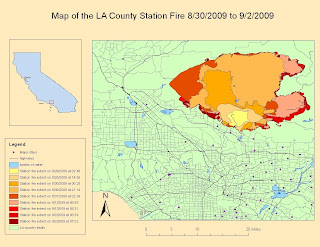 Reference map of the LA County Station fire
Reference map of the LA County Station fire Thematic map of the LA County Station Fire and its proximity to nearby cities and schools
Thematic map of the LA County Station Fire and its proximity to nearby cities and schoolsSome of the schools in the Los Angeles Unified School District were affected in the Station Fire in 2009 in a number of ways. One of the schools burned down, some of the schools were closed, some pushed back the first day of school, some were used as evacuation centers, and for some the fires interrupted sports summer practice. The thematic map I made illustrates the number of schools nearby the Station Fire.
The Los Angeles County Station Fire started in the southern portion of the Angeles National Forest and is one of the largest fires in L.A. county's modern history. The fire burned from August 26, 2009 until October 16, 2009 and burned 160,577 acres during that time (InciWeb). The reference map I made shows the area that was burned and the thematic map I made shows the burn area, the cities nearby, and illustrates the schools nearby.
During the almost two month fire, residents that live near the effected area had to evacuate. My map shows the cities in closest proximity to the fire during August 29, 2009 to September 2, 2009 which are La Crescenta and La Canada- Flintridge, and on later dates evacuations were also made in Glendale and Altadena, as well as other cities (ABC news). Knowing what cities were affected was important because it helped identify the area of which schools were affected.
The fire started while children were still on summer break, so most children were unaffected by the fire, however the schools themselves were still in harm's way. One school was burned down in during the fire, called Gateway school which was located near the Angeles National Forest, and the La Canada Unified School District pushed back the first day of school until the fire was contained and the air quality was suitable for the schools to be reopened (LAist).
Most of the schools were being used as evacuation centers for the evacuees at La Canada High School, Jackson Elementary School in Altadena and other schools in the area (Daily News). Schools in the Acton-Agua Dulce Unified, La Canada Unified, and Glendale Unified were closed because of the fire. Schools in the Pasadena, Sunland and San Fernando Valley Unified School Districts were on summer break during the time of the fire, but all sports summer practices were canceled due to air quality (LATimesblogs).
"Station Fire Forces More Evacuations." Abc30. 29 Aug. 2009. Web. 26 May 2010.
"InciWeb the Incident Information System: Station Fire News Release." InciWeb the Incident Information System: Current Incidents. Web. 26 May 2010.
"Station Fire Update: Evacuations, School Closures & Other Info - LAist." LAist: Los Angeles News, Food, Arts & Events. 30 Aug. 2009. Web. 26 May 2010.
"Wildfire Rages within Whisker of San Fernando Valley - LA Daily News." Home - LA Daily News. 30 Aug. 2009. Web. 8 June 2010. http://www.dailynews.com/news/ci_13230693




